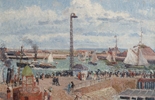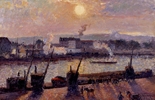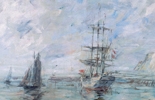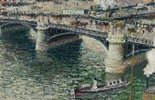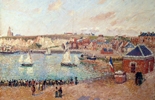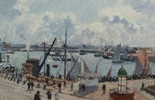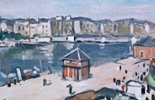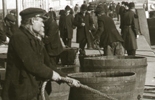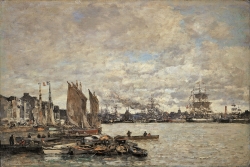
Eugène BOUDIN (1824-1898), Le Havre, ca. 1869. © Libérec, Oblastni Galerie v Liberci
Very early on in his career, the ports of Le Havre, Trouville, Honfleur and Deauville provided
Boudin with a wide range of subjects, and he was to depict features such as quays, docks and jetties over and over again throughout his life. Later, his travels in Brittany, Holland, the north and south of France and Venice were to inspire yet more harbour paintings.
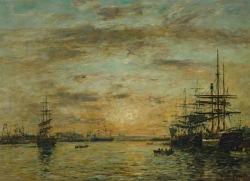
Eugène BOUDIN (1824-1898), Le Havre, Bassin de l’Eure, 1885, oil on canvas. Évreux, musée d’art, histoire et archéologie. © RMN-Grand Palais / Agence Bulloz
But
Boudin did not attempt to portray the port cities: he felt no attraction to the realities of urban life and had no urge to depict them in a realistic way. He usually chose a viewpoint near the water, often inside the docks rather than on the quays, and was a past master at conveying the tangled mass of rigging and masts of boats in dock, vessels manoeuvring, and the arrival and departure of great steam or sailing ships entering or leaving a harbour. This artistic stance relegates the location itself to a mere backdrop, sketched in but rarely documented in detail. Briefly sketched outlines of hangars, cranes, locks and masting sheers were enough to set the scene so that it could be identified.
Nor did
Boudin bother to record typical harbour activities or highlight issues, as
Pissarro and the neo-Impressionists were to do. He describes his feelings on getting to know Bordeaux − of which he nonetheless produced a much more realistic portrait, now in the Musée d'Orsay − as follows: "I don't much like the quays. The hubbub of coaches, packages and barrels there is just the same as in Le Havre or rather Antwerp − a pleasant whirl for those who consult [sic] their enjoyment by the number of bales and barrels lowered down by the cranes, but it doesn't amuse the dreamer who prefers a bit of quiet solitude and the less varied but more poetic voices of the natural elements."
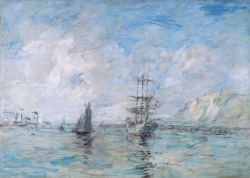
Eugène BOUDIN (1824-1898), The Port of Dieppe, ca. 1896, oil on canvas. © Honfleur, musée Eugène Boudin / Henri Brauner
In his own way,
Boudin is saying the same thing as
Pissarro when the latter remarks that the subject is secondary and all that counts is atmospheric effects. Throughout his career,
Boudin was primarily interested in the "meteorological beauties" that had captivated Baudelaire in 1859. He endeavoured to turn these atmospheric phenomena into pure pictorial compositions, as in
Twilight over the Bassin du Commerce in Le Havre, where the subject loses all substance, vanishing into a silent conflagration of sea air.





